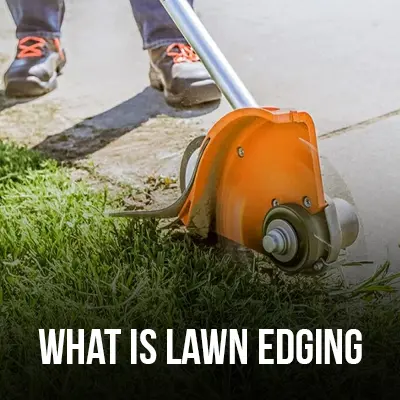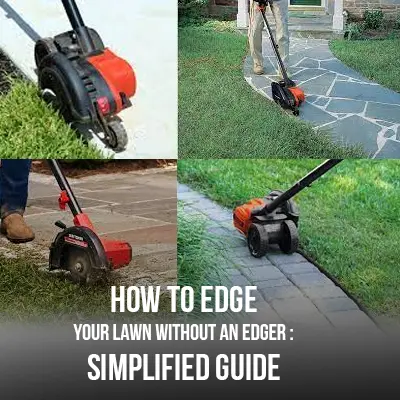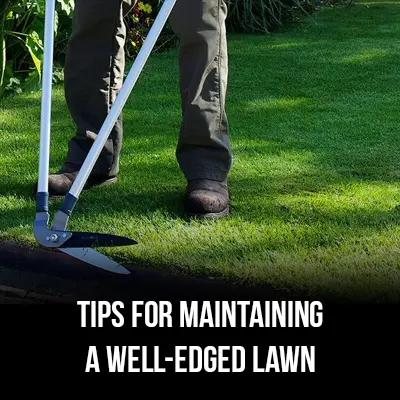
To edge a lawn without an edger, use a manual lawn edging tool or a sharp spade. These tools can create the same clean, precise edge as an edger machine.
For a more shiny look, use a straight edge, such as a board or metal strip, to guide your tool. A well-organized lawn can add curb appeal and increase your home’s value. Lawn edging helps determine the borders of your lawn, separating it from garden beds or walkways.
Using an edger machine can make temporary work of the task, but not everyone has access to one. Fortunately, there are manual tools that can provide the same professional-looking results. In this article, we’ll explore different methods of edging your lawn without an edger machine, including using a manual lawn edging tool and a spade. We’ll also provide tips for creating a straight, clean edge using a straight edge as a guide.
What Is Lawn Edging, And Why Is It Important?

Lawn edging refers to the process of creating a clear border between the lawn and other features such as the driveway, walkway, or garden beds. It is commonly done using an edger, which is a specialized tool that creates a straight line.
Lawn edging can also be completed using a spade or a rotary tool. The primary goal of lawn edging is to enhance the appearance of the lawn, creating a clean and polished look.
Some common types of lawn edging include:
1.Brick edging 2. Stone edging 3.Metal edging 4.Plastic edging
Benefits Of Lawn Edging
Lawn edging has numerous benefits, both for the aesthetics of the lawn and its maintenance. Here are some of the primary benefits of lawn edging:
- Better curb appeal: Lawn edging improves the look of the lawn, making it seem clean and shiny. It also creates a clear separation between the lawn and other features, giving your property a neat and organized look.
- Reduced maintenance: Lawn edging helps to prevent grass runners from spreading into flower beds or walkways, thereby reducing the need for trimming and weeding. Grass runners can be particularly determined to remove, so edging helps to avoid this problem.
- Easy mowing: Lawn edging marks the boundary between the lawn and other features, such as a walkway. This makes it easier to mow the lawn without damaging other elements, such as flowers or landscapes.
- Protection for plants: Lawn edging provides a physical barrier that prevents grass from violating plant beds, protecting plants from competition and damage from mowing equipment.
Lawn edging is a necessary aspect of lawn maintenance that enhances the appearance of your lawn, reduces maintenance, and provides protection for your plants. It is an easy and affordable way to give your property a clean and organized look.
Furthermore, consider reading: How Does a Lawn Edger Work
The Limitations Of Traditional Edging Methods
Maintaining a neatly trimmed lawn is essential to keep your yard looking tidy and well-manicured. Traditional grass edging methods, such as manual edgers and using a string trimmer, have been popular for many years. However, these methods come with several limitations that can affect the quality of your lawn.
Here are some key limitations you should be aware of:
- Manual edging limitations:
- Requires physical effort and time
- Can damage the edger if not used properly
- Limited flexibility in curves and edges
- Cannot guarantee consistent depth and width of the trench
- String trimmer limitations:
- Can cause damage to nearby objects and plants
- Can produce rough edges or angles
- This can result in weakened and frayed grass blades
- Cannot create perfectly straight edges
With these limitations, it is important to consider alternative lawn edging methods that can provide more precise and efficient results. In the next area, we will introduce you to some innovative edging techniques that can help you achieve a perfectly manicured lawn without using traditional edging methods.
How To Edge Your Lawn Without An Edger : Simplified Guide

Keeping your lawn properly edged is necessary to create that perfect look for your terrain. You may think that edging without an edger is a challenging task, but it’s not impossible. With the right tools and materials and a step-by-step process, you too can edge your lawn without an edger.
Tools And Materials You’ll Need
Before you begin edging your lawn, you should have the following tools and materials on hand:
- Garden spade or shovel
- Rope and stakes
- Lawnmower
- Safety glasses
- Work gloves
Step-By-Step Process
Follow these simple steps to edge your lawn like a pro without an edger:
- Define the edges: First, define the edges of your lawn by creating a visual guide using string and stakes. This will prevent you from accidentally edging into the surrounding landscaping.
- Mow the lawn: Mow the grass as close to the edge as possible. Make sure you wear safety glasses and work gloves to protect yourself.
- Use a garden spade or shovel: A garden spade or shovel will work as an alternative to an edger. Place the spade or shovel along the defined edge and use it to create a clean edge.
- Don’t cut too deep: Take care not to cut too deep into the soil or it will make it difficult for the grass to grow back.
- Repeat as needed: Once you have finished one section, move to the next and edge it in the same way. Repeat until you have edged the total lawn.
- Clean up: After edging, clean up any extra dirt or debris that has been collected in your working space.
Now that you have a better understanding of how to edge lawn without an edger, it’s time to put your new skills into action. With the help of this simplified guide, you can have a perfectly edged-lawn instantly!
Moreover, explore: How to Fix Lawn Edger
Tips For Maintaining A Well-Edged Lawn

A well-maintained lawn is a pleasure to the minds. Nothing beats the sight of a fresh lawn with neatly trimmed edges. However, maintaining a well-edged lawn can be a challenge, especially if you don’t have an edger. The following tips can help you maintain your lawn edges without an edger.
Regularly Inspect For Any Overgrowth
The first step in maintaining a well-edged lawn is to inspect the edges of your lawn regularly. Look out for overgrowth, which can make your lawn look messy. Overgrowth is common, especially around obstacles like trees or rocks. Use a pair of garden scissors or a pruning knife to trim the overgrown edges of your lawn.
Use A String Trimmer To Keep The Edges Neat And Tidy
A string trimmer can be a valuable tool for maintaining the edges of your lawn. String trimmers are affordable and easy to use, and they can be used to trim the edges of your lawn quickly and efficiently. To use a string trimmer, hold it parallel to the ground and move it back and forth along the edge of your lawn.
When using a string trimmer, it’s essential to wear the right protective equipment, like safety glasses and gloves, to avoid injury. Make sure to also keep the spinning line close to the ground to trim the edges as neatly as possible.
Maintain The Border By Regularly Applying Mulch Or Gravel
Maintaining the border of your lawn can be a challenge, especially if you do not have an edger. One solution is to create an edge using a border of mulch or gravel. Mulch and gravel can keep grass and weeds from growing into your flower beds and beyond, and they also make a neat border around your lawn.
To use mulch or gravel as an edger, create a border around the lawn with a trench. Fill the trench with mulch or gravel to create a boundary. This will help to create a neat boundary for your lawn.
Inspect And Fill Any Trench Irregularities Caused By Weather Or Other Factors
Over time, weather and other factors can cause trenches to become irregular, which can affect the appearance of your lawn. Inspect any trenches you have created in the past, filling in any irregularities and ensuring the edging is maintained. Try to complete this process regularly and after periods of bad weather or other damaging conditions.
By following these tips, you can maintain your lawn, even without an edger. A well-edged lawn is a beautiful sight that can give your home curb appeal and make your yard a pleasant place to calm. So why not improve your lawn edging today?
Additionally, it is worth mentioning: How to Use a Gas-Powered Lawn Edger
Frequently Asked Questions Of How To Edge Lawn Without An Edger
Can You Edge A Lawn Without An Edger?
Yes, you can edge a lawn without an edger by using a manual edging tool, a trimmer, a spade, or a garden knife. These tools require manual labor, but they can produce clean and neat lawn edging.
How Do You Edge A Lawn By Hand?
To edge a lawn by hand, use a manual edging tool or a spade to cut a shallow trench along the edge of the lawn. Keep the tool at a slight angle and follow the outlines of the lawn. Then, remove the excess soil and edge debris, and smooth out the trench.
Can You Edge A Lawn With A String Trimmer?
Yes, you can edge a lawn with a string trimmer by using the trimming line to cut through the grass at an angle. Hold the trimmer with a slight angle towards the lawn and follow the edge. This technique is ideal for small lawns or areas that are difficult to reach with an edger.
What Is The Best Time To Edge A Lawn?
The best time to edge a lawn is when the grass is dry, and the soil is moist. This makes the soil easier to cut, and the edge will appear clean and sharp. Edging should be done once or twice a month during the growing season to maintain the shape and look of the lawn.
How Often Should You Edge Your Lawn?
You should edge your lawn once or twice a month during the growing season. This will help maintain the shape and look of the lawn. However, the frequency of edging may vary depending on the grass type, climate, and the desired look of the lawn.
Conclusion
Maintaining a well-manicured lawn is a source of satisfaction for many homeowners. Using an edger to create a clean look is a popular choice, but not everyone has access to one. Fortunately, there are several alternative methods to edge your lawn without an edger.
By following the tips and techniques outlined in this blog post, you can create a polished look for your lawn. To summarize, use a blade or spade for manual edging, take advantage of your lawn mower’s wheels, and use string trimming as a last resort.
With patience and practice, you can achieve professional results and keep your lawn looking fresh. By implementing these techniques, you can maintain curb appeal and increase your property’s value. Happy edging!
